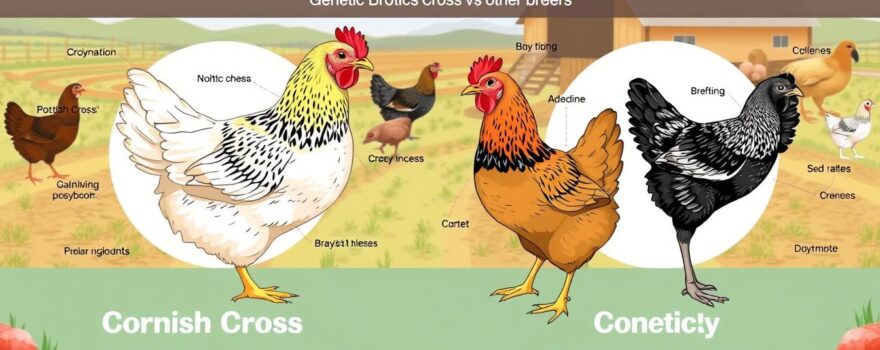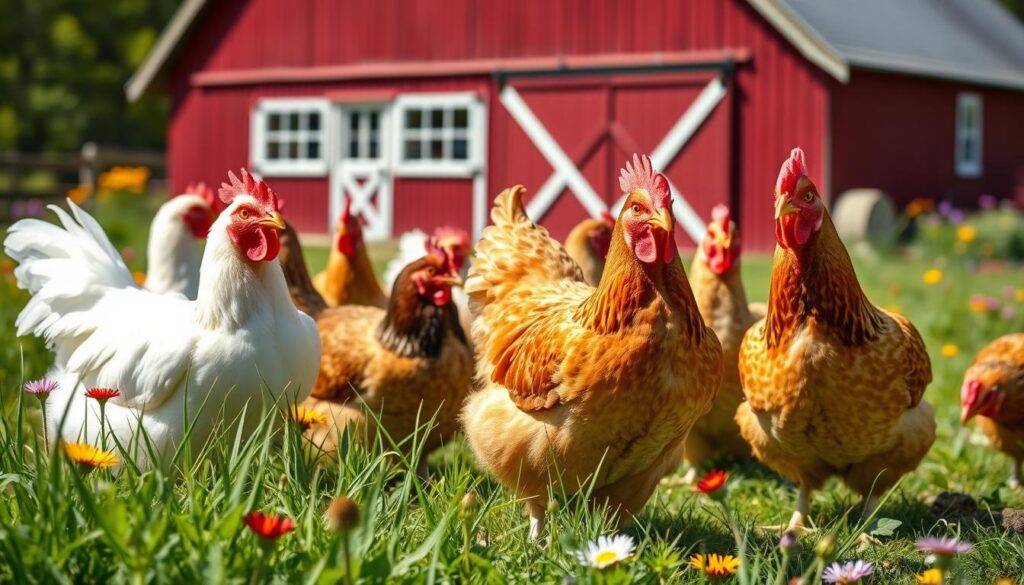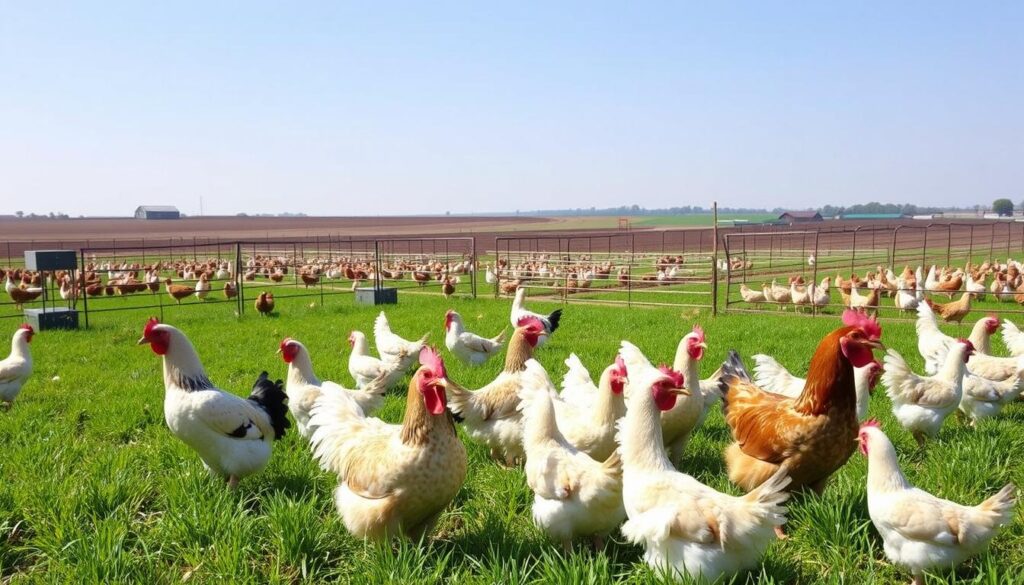
The Cornish Cross broiler is a top choice in commercial poultry farming. It’s known for growing fast and turning feed into meat efficiently. But, it’s important to know how it compares to other popular broiler breeds.
This article looks at the Cornish Cross and other breeds like Ross and Cobb. We’ll compare their origins, looks, growth rates, and how well they use feed. This helps farmers and buyers choose the best breed for their needs.
Understanding broiler genetics and selective breeding is key. This analysis explores the Cornish Cross and its role in the poultry industry. It aims to give a clear view of the Cornish Cross among today’s commercial broiler options.
What is a Cornish Cross Broiler?
The Cornish Cross broiler is a special chicken breed made for meat. It comes from mixing the Cornish and Plymouth Rock chickens. This mix gives it a strong build, wide breast, and grows fast.
Origins and History
In the 1940s, breeders and researchers worked together to make the Cornish Cross broiler. They mixed the strong Cornish with the productive Plymouth Rock to make a chicken that turns feed into good meat well. This effort started the Cornish Cross broiler we see today.
Physical Characteristics
- Broad, muscular build with a full, rounded breast
- Short, stocky legs and a compact, rectangular body shape
- Rapid growth rate, reaching market weight in just 5-7 weeks
- White or off-white plumage with a yellow skin and legs
The Cornish Cross broiler’s unique look comes from years of breeding for meat. This hybrid is key in poultry farming and helps a lot in meat production.
Differences Between Cornish Cross and Other Popular Broiler Breeds
The Cornish Cross is the top choice for commercial meat production. Yet, other broiler breeds have their own special traits. Knowing the differences between the Cornish Cross and breeds like Ross and Cobb can help farmers and poultry lovers.
The Cornish Cross grows very fast, reaching market weight in 4-6 weeks. This is much quicker than many other breeds. Its fast growth is due to breeding for more muscle and better feed use.
On the other hand, Ross and Cobb broilers grow slower, taking 6-8 weeks to reach market weight. They might not grow as fast as the Cornish Cross. But, they often live longer and are healthier.
Feed efficiency is another key difference. The Cornish Cross needs less feed to produce meat, making it cheaper for producers. But, this might mean the birds are not as healthy or long-lived.
Choosing between the Cornish Cross and other breeds depends on what the farmer wants. Knowing each breed’s unique traits helps farmers pick the best one for their operation.
Growth Rate Comparison
Broiler breeds differ in how fast they grow and how well they use feed. Let’s look at the growth rates of Cornish Cross, Ross, and Cobb broilers.
Cornish Cross vs. Ross Broiler
The Cornish Cross broiler grows very fast, reaching market weight in 5-6 weeks. The Ross broiler takes 6-7 weeks to get to the same size. The Cornish Cross grows faster because of its genetics, which focus on quick growth and muscle.
Cornish Cross vs. Cobb Broiler
The Cobb broiler grows slower than the Cornish Cross, taking 6-8 weeks to reach market weight. The Cornish Cross, however, grows faster, making it more efficient for meat production.
| Broiler Breed | Average Growth Rate (Weeks to Market Weight) |
|---|---|
| Cornish Cross | 5-6 weeks |
| Ross Broiler | 6-7 weeks |
| Cobb Broiler | 6-8 weeks |
The Cornish Cross broiler’s fast growth and efficient feed use make it a top choice for meat production. But, its quick growth can raise health and welfare concerns, which we’ll discuss next.
Feed Efficiency and Meat Production
In poultry farming, feed efficiency is key to success. Broiler chickens’ ability to turn feed into meat is closely watched. The Cornish Cross broiler leads in this area.
The Cornish Cross is known for its broiler feed efficiency. This means it uses less feed to gain more weight. It’s bred to make the most of Cornish Cross feed conversion into tasty meat yield. This makes it a top choice for commercial farmers.
| Breed | Feed Conversion Ratio | Average Meat Yield |
|---|---|---|
| Cornish Cross | 1.6:1 | 5 lbs |
| Ross Broiler | 1.8:1 | 4.5 lbs |
| Cobb Broiler | 1.7:1 | 4.8 lbs |
The Cornish Cross’s high broiler feed efficiency and meat yield make it great for poultry farming economics. Farmers choose it for better returns. It means more meat sales with less feed, boosting profits and sustainability.
Breed Characteristics
Broiler chickens, like the Cornish Cross, have special traits that make them stand out. Knowing these traits is key for good poultry farm management. It helps keep your birds happy and healthy.
Temperament and Behavior
The Cornish Cross broiler is calm and gentle. They grow fast and gain weight quickly because they are less active. On the other hand, breeds like the Freedom Ranger and Red Broiler are more active and curious. They like to explore and forage more.
The Cornish Cross is easy to manage because they are calm. They don’t fight much or flap their wings a lot. This makes it easier for farmers to take care of them.
| Breed | Temperament | Behavior |
|---|---|---|
| Cornish Cross | Calm and docile | Less active, more sedentary |
| Freedom Ranger | Active and curious | More active foraging behavior |
| Red Broiler | Active and inquisitive | Engaging in more flapping and wing-stretching |
Understanding the special traits of broiler breeds helps farmers manage their farms better. It leads to a happy and productive flock.
Advantages of Cornish Cross Broilers
The Cornish Cross broiler has many benefits that make it a top choice for commercial meat production. It is known for its fast growth and efficiency in farming. These traits make it a favorite among poultry farmers.
This breed grows quickly, reaching market weight in just 5-6 weeks. This is faster than most other broilers, which take 8-10 weeks. This fast growth means farmers can produce more meat and make more money.
The Cornish Cross also needs less food to grow, which saves money. This efficient use of feed is a big plus in the competitive commercial broiler market.
This breed is also easy to adapt to different farming sizes. It does well in both small-scale and large-scale farms. Its strong health and resistance to diseases also make it popular among farmers.

While the Cornish Cross has some downsides, its benefits are clear. Its fast growth, efficient feed use, and adaptability make it a top choice for farmers. It helps farmers increase their meat production efficiency and profits.
Drawbacks of Cornish Cross Broilers
The Cornish Cross broiler is known for growing fast and using less feed. But, it also has some big downsides. These include health problems and ethical issues that are important to know about.
Health Concerns
The fast growth of Cornish Cross broilers can lead to health issues. They often get skeletal problems, heart diseases, and metabolic disorders. These can cause a lot of pain and even death early on.
Because they grow so fast, their bones and organs don’t keep up. This can lead to problems like lameness and trouble moving around.
Ethical Considerations
The way Cornish Cross broilers are raised has raised many concerns. People worry about broiler welfare and sustainable poultry farming. These birds are often kept in very crowded, stressful conditions.
This can lead to stress, behavioral problems, and a poor quality of life. The Cornish Cross broiler disadvantages have sparked debates about the ethics of raising poultry today.
As the poultry industry changes, the effects of these Cornish Cross broiler disadvantages on animals and the environment will become more important. They will shape the future of raising broilers.
Broiler Genetics and Selective Breeding
The evolution of broiler breeds, like the Cornish Cross, is thanks to genetic research and selective breeding. These efforts have changed the poultry industry. They’ve made meat production better and met the world’s need for affordable, quality protein.
The key to this change is broiler genetics. Scientists have studied broiler chickens’ genes to find traits that improve growth, feed use, and meat quality. This has led to broilers that grow faster and use feed better than before.
The selective breeding process is very detailed. It involves keeping records, analyzing data, and choosing the right mates. This careful selection has created broiler lines that are perfect for the poultry industry innovation.
| Trait | Historical Broiler | Modern Broiler |
|---|---|---|
| Growth Rate | Slower | Faster |
| Feed Efficiency | Lower | Higher |
| Meat Yield | Lower | Higher |
The effects of broiler genetics and selective breeding are clear. They’ve changed the poultry industry and made chicken meat more available and affordable worldwide.
Choosing the Right Broiler Breed for Your Farm
Choosing the right broiler breed for your farm can be tough. There are many breeds, each with its own needs and traits. This section offers tips to help you pick the best breed for your farm.
When picking a broiler breed, growth rate is important. Fast-growing breeds like the Cornish Cross grow quickly. But slower-growing breeds, like the Jersey Giant, may have better meat quality.
| Breed | Average Growth Rate | Meat Quality | Feed Efficiency |
|---|---|---|---|
| Cornish Cross | Fast | Good | High |
| Jersey Giant | Moderate | Excellent | Moderate |
| Orpington | Slow | Good | Low |
Feed efficiency is also key. Some breeds, like the Cobb Broiler, use less feed. This can save money and boost production. Other breeds, like the Dark Cornish, may need more resources but offer special flavors.
By looking at the different breeds and their traits, you can choose wisely. This ensures your farm’s success in the long run.

Impact on the Poultry Industry and Consumer Market
The Cornish Cross broiler has made a big impact on the poultry industry and what people like to eat. It’s the top choice for commercial meat production. This has changed how chicken is seen and made in the industry.
Its fast growth and good meat yield are key reasons it’s so popular. It helps meet the demand for cheap and easy-to-get chicken. This is good for both farmers and those who buy chicken.
The Cornish Cross chicken has also changed what people want to eat. It’s known for its consistent, high-quality meat. This has made it a favorite for those looking for affordable, reliable, and sometimes ethically raised chicken.
This shift has made the market focus more on where and how chicken is made. People want to know more about their food.
But, the use of Cornish Cross has raised questions about sustainability and animal welfare. As people think more about the environment and animal treatment, the industry needs to change. It must find new ways to meet consumer needs while keeping costs and efficiency high.